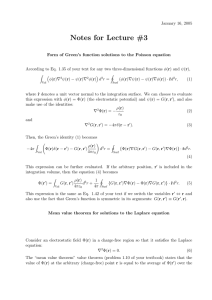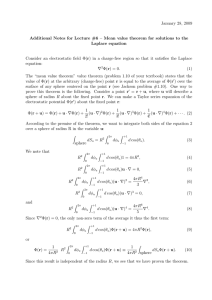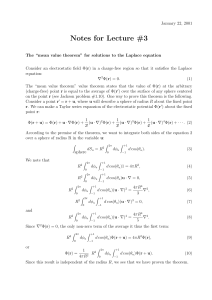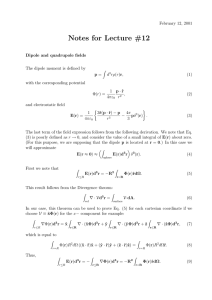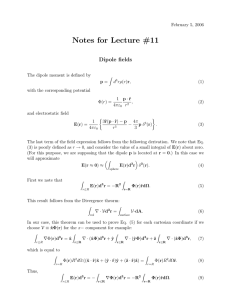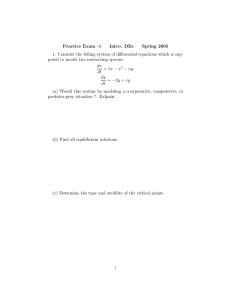Notes for Lecture #3
advertisement
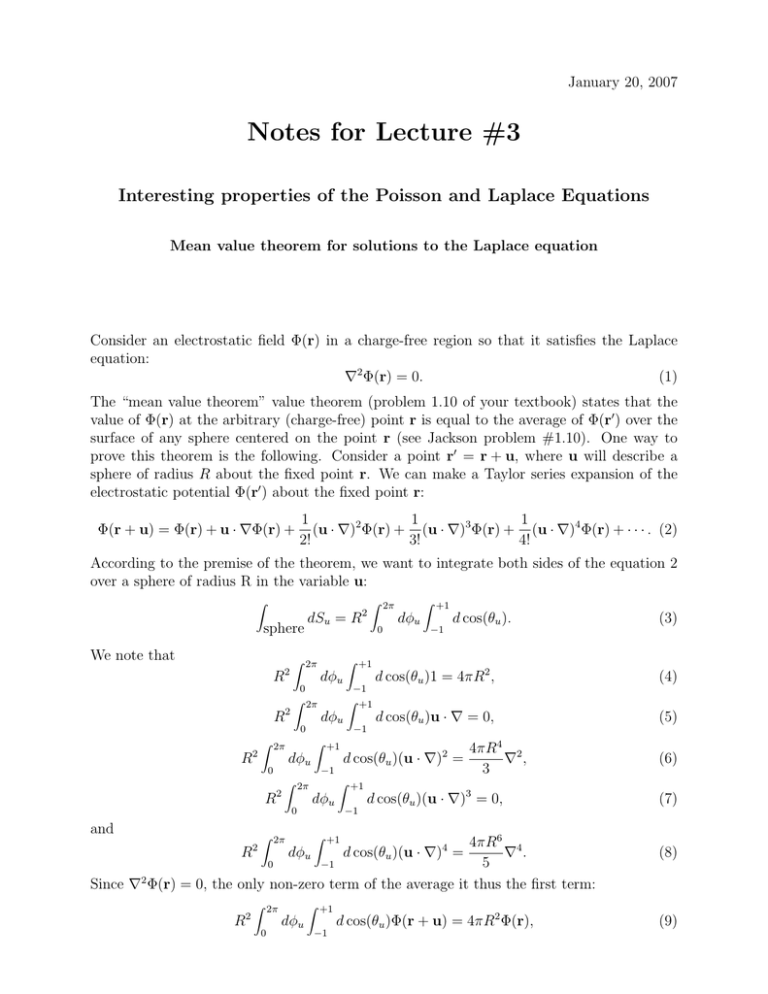
January 20, 2007
Notes for Lecture #3
Interesting properties of the Poisson and Laplace Equations
Mean value theorem for solutions to the Laplace equation
Consider an electrostatic field Φ(r) in a charge-free region so that it satisfies the Laplace
equation:
∇2 Φ(r) = 0.
(1)
The “mean value theorem” value theorem (problem 1.10 of your textbook) states that the
value of Φ(r) at the arbitrary (charge-free) point r is equal to the average of Φ(r0 ) over the
surface of any sphere centered on the point r (see Jackson problem #1.10). One way to
prove this theorem is the following. Consider a point r0 = r + u, where u will describe a
sphere of radius R about the fixed point r. We can make a Taylor series expansion of the
electrostatic potential Φ(r0 ) about the fixed point r:
Φ(r + u) = Φ(r) + u · ∇Φ(r) +
1
1
1
(u · ∇)2 Φ(r) + (u · ∇)3 Φ(r) + (u · ∇)4 Φ(r) + · · · . (2)
2!
3!
4!
According to the premise of the theorem, we want to integrate both sides of the equation 2
over a sphere of radius R in the variable u:
Z
sphere
We note that
R2
R2
R
2
Z 2π
0
R
and
2
dSu = R
Z 2π
0
Z 2π
0
dφu
Z 2π
0
Z 2π
dφu
Z +1
−1
dφu
Z +1
−1
d cos(θu ).
−1
(4)
d cos(θu )u · ∇ = 0,
(5)
4πR4 2
∇,
3
d cos(θu )(u · ∇)3 = 0,
4πR6 4
∇.
5
−1
0
Since ∇2 Φ(r) = 0, the only non-zero term of the average it thus the first term:
R2
R2
Z 2π
0
dφu
dφu
Z +1
−1
(3)
d cos(θu )1 = 4πR2 ,
d cos(θu )(u · ∇)2 =
Z +1
Z +1
0
−1
dφu
−1
Z 2π
Z +1
dφu
Z +1
2
d cos(θu )(u · ∇)4 =
d cos(θu )Φ(r + u) = 4πR2 Φ(r),
(6)
(7)
(8)
(9)
or
Z 2π
Z +1
1
1 Z
2
d
cos(θ
)Φ(r
+
u)
≡
R
dφ
dSu Φ(r + u).
u
u
4πR2
4πR2 sphere
−1
0
Φ(r) =
(10)
Since this result is independent of the radius R, we see that we have proven the theorem.
Form of Green’s function solutions to the Poisson equation
According to Eq. 1.35 of your text for any two three-dimensional functions φ(r) and ψ(r),
Z
³
Vol
2
2
´
I
3
φ(r)∇ ψ(r) − ψ(r)∇ φ(r) d r =
Surf
(φ(r)∇ψ(r) − ψ(r)∇φ(r)) · r̂d2 r,
(11)
where r̂ denotes a unit vector normal to the integration surface. We can choose to evaluate
this expression with φ(r) = Φ(r) (the electrostatic potential) and ψ(r) = G(r, r0 ), and also
make use of the identities:
ρ(r)
∇2 Φ(r) = −
(12)
ε0
and
∇2 G(r, r0 ) = −4πδ(r − r0 ).
(13)
Then, the Green’s identity (11) becomes
Z
−4π
Ã
!
I
ρ(r)
3
Φ(r)δ(r − r ) − G(r, r )
dr=
{Φ(r)∇G(r, r0 ) − G(r, r0 )∇Φ(r)} · r̂d2 r.
4πε0
Surf
(14)
0
Vol
0
This expression can be further evaluated. If the arbitrary position, r0 is included in the
integration volume, then the equation (14) becomes
Z
Φ(r0 ) =
Vol
G(r, r0 )
1 I
ρ(r) 3
d r+
{G(r, r0 )∇Φ(r) − Φ(r)∇G(r, r0 )} · r̂d2 r.
4πε0
4π Surf
(15)
This expression is the same as Eq. 1.42 of your text if we switch the variables r0 ⇔ r and
also use the fact that Green’s function is symmetric in its arguments: G(r, r0 ) ≡ G(r0 , r).
